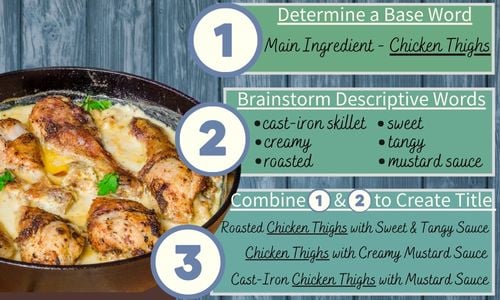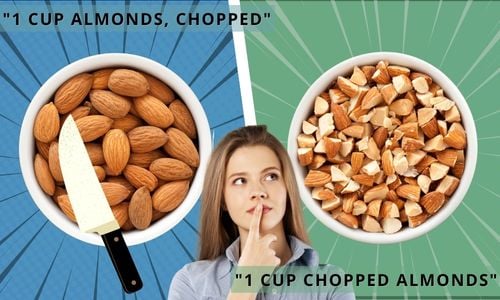Share on social!
Whether you’re interested in creating recipes for clients, your food blog, social media, a cookbook, or brand partnerships, building a strong base of recipe writing knowledge is important to achieve success. In this article, we’ll explore the 5 must-have components of a recipe (plus 3 bonus components!). From ingredients to step-by-step instructions, we’ll cover the basics of recipe writing that will help you write better recipes and create delicious meals every time.
You are watching: 5 Must-Have Components of a Recipe
- Are you new to recipe writing?
- Unsure what the essential components of a recipe are and what each entail?
- Looking for tips to improve the professional quality of your existing recipes?
You’ll also find best practice tips and examples you can use to help you get started writing recipes like a pro. So, let’s dive in and discover the essentials of recipe writing!
What are the Key Components of a Recipe?

The 5 essential components of a recipe are:
- Recipe Title
- Number of Servings
- Preparation Time, Cooking Time, Total Time
- Ingredient List
- Step-by-Step Instructions
Each component plays a fundamental role in creating a recipe that’s easy to follow and produces consistent results time and time again. While you’re probably familiar with seeing these components in recipes you’ve used in the past, when it comes to writing recipes yourself, it’s common to have questions in the beginning:
- “How do I write a good recipe title?”
- “Is it okay to use abbreviations like tbsp and tsp?”
- “What is the best way to explain a “divided” ingredient in the recipe directions?”
In this post we’ll go over these details and more as we take a closer look at each component.
1) Recipe Title
The recipe title is a key component of a recipe because it’s one of the first parts that draws in your audience. By adding a few descriptive words to the title: “quick,” “one-pot,” “dairy-free, “make-ahead,” you can let the reader know important details that may be the deciding factor in whether they continue reading or search for another recipe. Therefore, why not take the time to come up with a quality title.
Feeling stuck coming up with a good recipe title?
Here is a 3-step method for crafting a simple, yet descriptive title.
Step 1: Determine a base word to build your title around. Ask yourself:
- What are 1 or 2 main ingredients in the recipe that I want to highlight?
- Does this recipe fall under a certain type of dish (burger, casserole, muffins, salad, tacos, etc.)?
Step 2: Brainstorm a list of 5 or more words to describe your recipe. Consider the following categories and examples for inspiration.
- Equipment Used: air-fryer, cast-iron skillet, instant pot, sheet pan, slow cooker
- Preparation Method: baked, blanched, charred, roasted, stir-fry
- Served with ____: dressing, sauce, salsa, topping
- Noteworthy Ingredients and Flavors: herbs and spices, smoky, sweet, tangy
- Texture: chewy, creamy, crispy, hearty, sticky
Step 3: Create a title by taking the base word from step 1 and pairing it with words from your brainstorm list in step 2. Play around with different word combinations to come up with a few titles to choose from.
The image below shows an example applying this 3-step method to craft a title for a recipe using “chicken thighs” as the base word.

By combing “chicken thighs” with just a few words from the brainstorm list, we are able to come up with 3 good options to name our dish.
2) Number of Servings
Rather than leave the reader wondering if your recipe for make-ahead oatmeal will be enough to feed a family of 4, be sure to include the number of servings component.
Read more : Homemade Shampoo For Hair Growth – Know How To Make It
Typically found near the top of the recipe under the title, number of servings is commonly stated using words like: “serves,” “yield,” and “makes.” For instance:
- Serves: 4
- Yield: 8 to 10 servings
- Makes: 24 cookies
Do I need to include portion size too?
Going a step further to also include portion size information is beneficial for a number of reasons. First, it is another marker to help the home cook gauge how much a recipe makes and how to more accurately scale the ingredients if needed.
- Serves 4, 2 cups salad each
- Yield: 8 servings (serving size: about 3 ounces chicken and ¾ cup sauce)
- Makes: 24, 4-inch cookies
Secondly, it helps with consistency in the final product, ensuring there is enough sauce for each serving of chicken, for example.
Thirdly, portion size is key if including a nutrition analysis breakdown with your recipes (one of the BONUS recipe components we will discuss later).
3) Prep Time vs Cook Time vs Total Time
There are several ways to state how long it takes to put a recipe together.
Take a look at these 2 snapshots of recipes. Upon looking at the first recipe you’ll notice time is written as Active and Total. The second recipe breaks down time into: Total, Prep, Inactive and Cook.

Source: https://www.eatingwell.com/recipe/275038/cauliflower-tikka-masala-with-chickpeas/
Source: https://www.foodnetwork.com/recipes/garden-pasta-salad-recipe-1916563
At minimum, Total time should be stated in your recipe. However, providing the reader with one or more additional time estimations (Prep, Cook, Active, Inactive) is yet another way to help set them up for cooking success and ultimately can increase the likelihood they’ll try out more of your recipes in the future.
Key takeaways when referencing time projections in your recipes:
- Prep time does NOT include the time it takes to cut and prepare each item for how it is written in the Ingredient List.
- Inactive time includes how long it takes for actions such as: chilling, marinating, cooling, dough rising
- Active time is made up of Prep and Cook time.
- Total time = Prep + Cook + Inactive
- If the Total time does NOT include Inactive time consider adding a note such as: “Total Time: 2 Hours, plus time to chill the dough and cool the pie”
One final note, testing your recipe multiple times and keeping detailed notes throughout the process is key to producing quality recipes. During recipe testing, it can be easy to forget to double check your time estimates while you’re focusing on other parts of the recipe like ingredient amounts and order of steps. However, remember to set the timer and maintain notes for each step, in order to provide time estimations that are as accurate as possible.
4) Ingredient List
When it comes to writing this part of a recipe, the most important rule to follow is listing the ingredients in the order they will be used. Basically, the ingredients should match up with the order in which they appear in the step-by-step instructions.
What if multiple ingredients are used at one time? For instance, a recipe calls for adding ground cumin, ground coriander and salt to a small bowl before mixing. In this case, list the ingredients in order by amount, from largest to smallest: 1 teaspoon ground cumin, ½ teaspoon ground coriander, ¼ teaspoon salt.
As with all other forms of writing, remember to spell check, looking out for commonly misspelled food words. A basic, yet important step for recipe writing like a pro.
Read more : How to Whiten Teeth with Baking Soda: 7 Methods
Here are a few more best practice tips to follow (with examples!):
- Write out measurements (no abbreviations): pint, cup, tablespoon, teaspoon, pound, ounce, etc.
- Use “divided” if an ingredient is used more than one time in the recipe: “1 teaspoon salt, divided” or “1/3 cup canola oil plus 2 tablespoons, divided”
- Avoid the confusion: INSTEAD OF “2 5-ounce cans tuna,” WRITE “2 (5-ounce) cans tuna” or “two 5-ounce cans tuna”
- Capitalize the first letter of an ingredient when a number does not precede it: “Ground pepper” vs “1 teaspoon ground pepper”
- Double check ingredients are worded as intended: “1 cup almonds, chopped” means to measure 1 cup of almonds and then chop them vs “1 cup chopped almonds” indicates measuring 1 cup of already chopped almonds

5) Step-by-Step Instructions
Last but not least, let’s discuss the recipe directions, or preparation method. As stated in the previous section, the ingredient list and recipe directions go hand-in-hand.
TIP: Use a printed copy of your recipe for proofreading and ensure the order of ingredients coincide with their use in the instructions. Consider asking a friend to make the dish using your recipe and give feedback on the instructions.
How do I address “divided” ingredients in the recipe directions?
Typically, recipe directions do not include ingredient amounts because the amount is already stated in the ingredient list. HOWEVER, when you have a “divided” ingredient, you need to write the amount needed EACH time it is discussed in the directions.

Recipe Source: https://www.eatingwell.com/recipe/280060/chicken-pita-sandwiches-with-harissa-sauce/
For example, in the image above, the recipe lists “1/2 teaspoon kosher salt, divided,” and “1/2 teaspoon ground pepper, divided” in the ingredients section. Then in the directions, the specific amounts of salt and pepper are written each of the three times they are added in the recipe.
There are a few other essential details related to: temperature, equipment, and timing and doneness, that should be written into the step-by-step instructions. Here are wording examples that apply to each.
- Temperature: “Preheat oven to 350°F,” “Heat over medium-high heat”
- Equipment: “shred with 2 forks,” “in a large mixing bowl,” “spray a 2-quart baking dish”
- Timing and Doneness: “Bake for 8-10 minutes, until lightly browned around the edges,” “Roast until chicken registers 165°F on a digital thermometer, 40 to 45 minutes”
TIP: For beginner recipe writers it might be helpful to keep a list of wording examples like these to use as a quick reference guide when writing.
3 BONUS Components of a Recipe
Here are 3 more components of a recipe AND reasons why they are worth considering.
Recipe Headnote:
- opportunity to connect with your audience and get them excited to cook the dish
- provide a story or background on the recipe
Nutrition Analysis:
- important information that your audience is interested in
- tools like FoodData Central and recipe analyzer sites make calculating nutrient breakdown fairly quick and easy
Recipe Notes:
- include extra details that readers may value such as tips for make-ahead preparation, storage, and recipe variations
- give further clarification on recipe steps without being too wordy in the directions section

Final Thoughts
While this post is by no means an exhaustive list of the do’s and don’ts when it comes to the 5 must-have components of a recipe, it is meant to help beginners get started writing recipes more confidently. In addition to the tips and best practice recommendations provided, remember to brush up on your kitchen lingo (mis en place, al dente, coulis), making sure cooking terms are used appropriately.
Get started by writing recipes for dishes that you regularly make. Even if it’s a simple smoothie, basic salad, or bowl of oatmeal. The less complex the dish the better! Recipe contests are another fun way to practice your recipe development and writing skills (you might even win). As with any skill, recipe writing improves the more you do it. So get to it and keep it up!
Source: https://gardencourte.com
Categories: Recipe
